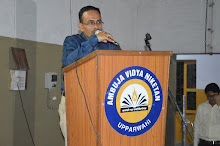Posted by : Empowerment Rules the World
Tuesday, 18 December 2018
Introduction
The writer Vikram Seth came from China to India hitchhiking via tibet and Nepal and wrote about it in his book titled ‘Heaven Lake’. In this excerpt from the book, we get to know about his visit to Kathmandu, the capital of Nepal.
Lesson and Explanation
I GET a cheap room in the centre of town and sleep for hours. The next morning, with Mr Shah’s son and nephew, I visit the two temples in Kathmandu that are most sacred to Hindus and Buddhists.
Vikram took a cheap, affordable hotel room on rent and as he was tired from the journey, he slept for a few hours. The next morning he visited two temples in Kathmandu along with Mr.Shah’s son and nephew. One of the temples was a pilgrimage for Hindus and the other one of the Buddhists.
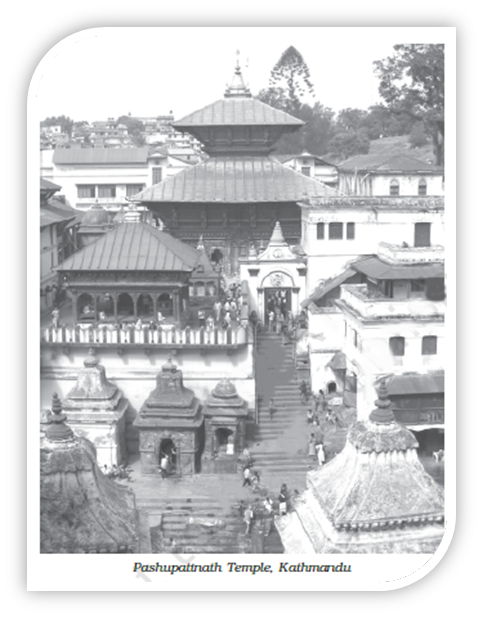
At Pashupatinath (outside which a sign proclaims ‘Entrance for the Hindus only’) there is an atmosphere of ‘febrile confusion’. Priests, hawkers, devotees, tourists, cows, monkeys, pigeons and dogs roam through the grounds. We offer a few flowers. There are so many worshippers that some people trying to get the priest’s attention are elbowed aside by others pushing their way to the front. A princess of the Nepalese royal house appears; everyone bows and makes way. By the main gate, a party of saffron-clad Westerners struggle for permission to enter. The policeman is not convinced that they are ‘the Hindus’ (only Hindus are allowed to enter the temple). A fight breaks out between two monkeys. One chases the other, who jumps onto a shivalinga, then runs screaming around the temples and down to the river, the holy Bagmati, that flows below. A corpse is being cremated on its banks; washerwomen are at their work and children bathe. From a balcony a basket of flowers and leaves, old offerings now wilted, is dropped into the river. A small shrine half protrudes from the stone platform on the river bank. When it emerges fully, the goddess inside will escape, and the evil period of the Kaliyuga will end on earth.
Proclaims: make known publicly or officially
Febrile confusion: hurried activity; complete chaos
Saffron - clad westerners: foreigners dressed as sadhus
Corpse: dead body
Wilted: dry and withered
Shrine: a place of worship
Protrudes: comes out
Kalyug: it is the fourth and last stages or time period of a Mahayuga. It started with the end of Mahabharata when Lord Krishna left the Earth.
Outside the Pashupatinath temple, a board was hung which read that entry into the temple was restricted to Hindus only. There was chaos outside the temple as priests, hawkers, devotees, tourists and various animals moved around. They writer and his friends offered a few flowers in the temple. There was a huge rush of pilgrims and they were elbowing each other in order to move ahead and reach the priest. As a royal princess appeared, everyone got aside to give way and bowed to her. At the main entrance, a group of foreigners who were dressed up in saffron colour clothes like sadhus were trying to gain entry into the temple. The guard denied entry as he knew that they were not hindus. Then he saw two monkeys fighting and one chased the other who jumped onto a shivling, then ran around the temple and finally, reached the banks of the holy Bagmati river which flows next to the temple. There he saw a dead body being cremated, washerwomen washing clothes and children bathing in the river. The writer noticed how the river was being polluted when a basket of dry withered flowers was thrown into it from the balcony of a building. A small temple protruded from the platform on the river bank. It is said that when the temple would emerge out completely, then the goddess in it would come out and the time period of the Kalyug would thus be ended by her.
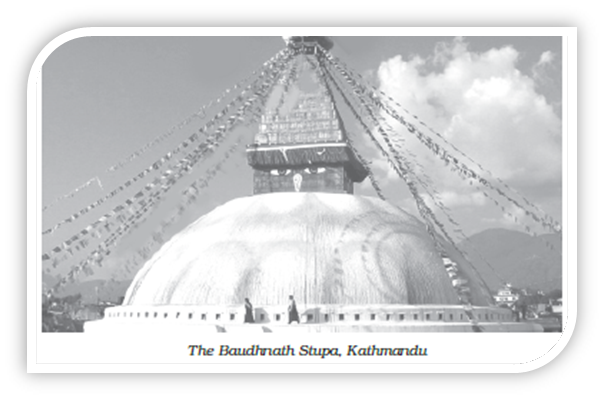
At the Boudhnath stupa, the Buddhist shrine of Kathmandu, there is, in contrast, a sense of stillness. Its immense white dome is ringed by a road. Small shops stand on its outer edge: many of these are owned by Tibetan immigrants; felt bags, Tibetan prints and silver jewellery can be bought here. There are no crowds: this is a haven of quietness in the busy streets around.
Immigrants: a person who comes to live permanently in a foreign country.
Haven: a safe place
Then the writer describes the Boudhanath temple which is a holy place for Buddhists. The place had a feel of calmness. There was a huge white - coloured dome circumscribed by a road. There was a Tibetan market on the edge of the road where immigrants from Tibet had out up shops selling felt bags, printed dresses and silver jewellery. There were no crowds and contrary to the scene at the Pashupatinath temple, the Baudhnath temple was calm and quiet with busy streets surrounding it.

Kathmandu is vivid, mercenary, religious, with small shrines to flower-adorned deities along the narrowest and busiest streets; with fruit sellers, flute sellers, hawkers of postcards; shops selling Western cosmetics, film rolls and chocolate; or copper utensils and Nepalese antiques. Film songs blare out from the radios, car horns sound, bicycle bells ring, stray cows low questioningly at motorcycles, vendors shout out their wares. I indulge myself mindlessly: buy a bar of marzipan, a corn on- the-cob roasted in a charcoal brazier on the pavement (rubbed with salt, chilli powder and lemon); a couple of love story comics, and even a Reader’s Digest. All this I wash down with Coca Cola and a nauseating orange drink, and feel much the better for it.
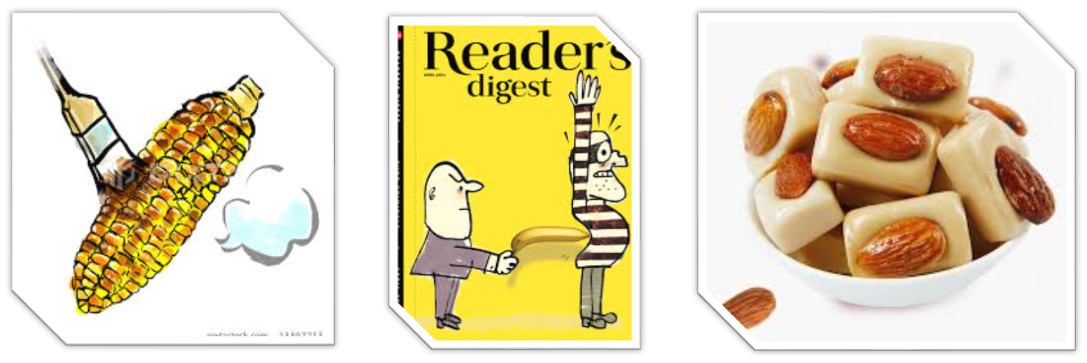
Deities: gods and goddesses
Cows low: the ‘moo’ sound made by cows
Marzipan: a sweet made with grated almonds
Brazier: open stove
Wash down: to drink something after a meal to digest it
Nauseating: sickening
The writer describes Kathmandu - the city has many different things to offer. It is a business hub, has religious places with many shrines, deities decorated with flowers on the narrow busy streets. There are hawkers selling fruits, flutes, postcards for the tourists. You can find many shops selling imported cosmetics, film rolls which were used in the old cameras, chocolates, copper utensils and Nepalese antiques. Many different sounds can be heard like music from the radio, car horn, bicycle bells, moo sound of the cows and screaming vendors selling their wares. The writer bought a bar of marzipan, a corn on the cob which had been roasted on charcoal fire by a roadside vendor. He had garnished it with lemon juice, salt and chilli powder. He also bought some love story comics and a Reader’s Digest magazine too. After eating all the things, he drank coca cola which is an aerated drink and would help him digest the food easily.
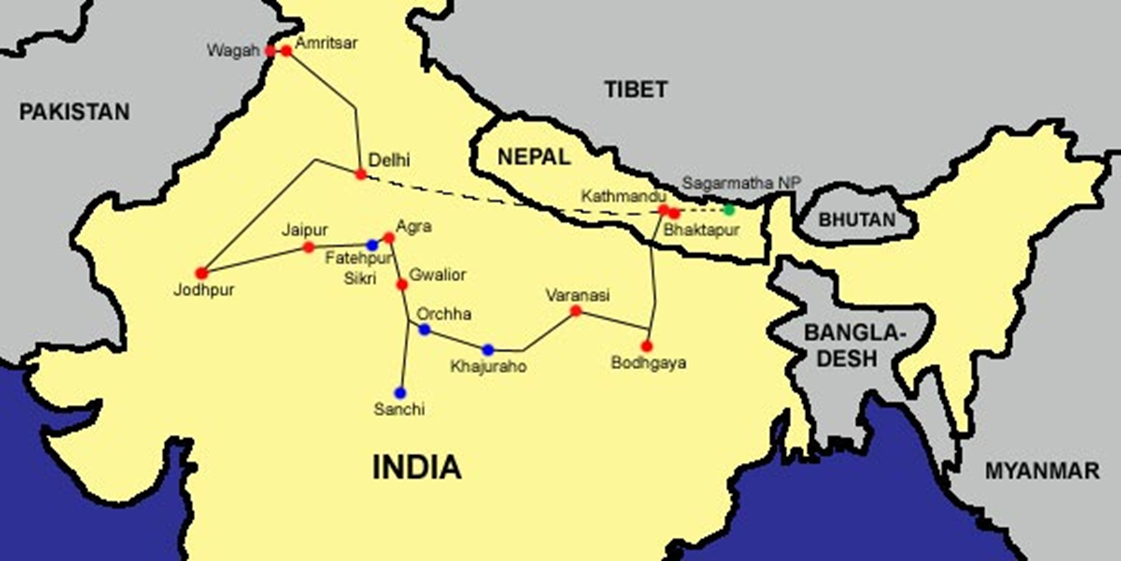
I consider what route I should take back home. If I were propelled by enthusiasm for travel per se, I would go by bus and train to Patna, then sail up the Ganges past Benaras to Allahabad, then up the Yamuna, past Agra to Delhi. But I am too exhausted and homesick; today is the last day of August. Go home, I tell myself: move directly towards home. I enter a Nepal Airlines office and buy a ticket for tomorrow’s flight.
Propelled: drive or push something forward
Per se: by itself
He thought of taking an adventurous route back home. It would be a bus or train journey till Patna. From there he would sail in a boat on the Ganga river and cross Benaras to reach Allahabad. From Allahabad, he would sail upon the Yamuna river, cross Agra and reach Delhi. He gave up this adventurous trip and decided to take a flight from Kathmandu to New Delhi as he was exhausted. He purchased a ticket from the Nepal Airlines office for the next day’s flight.
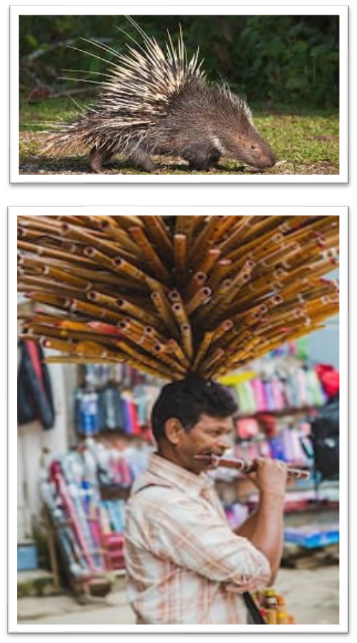
I look at the flute seller standing in a corner of the square near the hotel. In his hand is a pole with an attachment at the top from which fifty or sixty bansuris protrude in all directions, like the quills of a porcupine. They are of bamboo: there are cross-flutes and recorders. From time to time he stands the pole on the ground, selects a flute and plays for a few minutes. The sound rises clearly above the noise of the traffic and the hawkers’ cries. He plays slowly, meditatively, without excessive display. He does not shout out his wares. Occasionally he makes a sale, but in a curiously offhanded way as if this were incidental to his enterprise. Sometimes he breaks off playing to talk to the fruit seller. I imagine that this has been the pattern of his life for years.
Meditatively: thoughtfully
Offhanded: casual; not showing much interest in something
The writer saw a flute seller selling different bansuris. He was different from other hawkers. The was standing in a corner of the square outside the hotel. He was holding a pole which had an attachment on top of it. There were 50 60 flutes stuck in it. It resembled the thorny body of a porcupine. There were flutes made of bamboo and also cross flutes and recorders. The man would keep the pole on the ground and would play different flutes for short durations. He was calm, only the music of the flute could be heard. He played it meditatively and was not anxious to attract attention. At times he sold one flute but did not seem too interested to have a good sale. He would take breaks to talk to the fruit seller standing next to him. It seemed that this had been his routine since many years.
I find it difficult to tear myself away from the square. Flute music always does this to me: it is at once the most universal and most particular of sounds. There is no culture that does not have its flute — the reed neh, the recorder, the Japanese
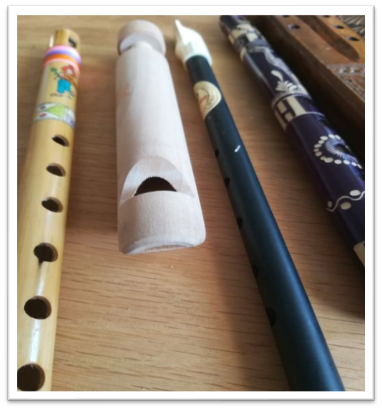
shakuhachi, the deep bansuri of Hindustani classical music, the clear or breathy flutes of South America, the high-pitched Chinese flutes. Each has its specific fingering and compass. It weaves its own associations. Yet to hear any flute is, it seems to me, to be drawn into the commonality of all mankind, to be moved by music closest in its phrases and sentences to the human voice. Its motive force too is living breath: it too needs to pause and breathe before it can go on.
Fingering: way of placing the fingers to play different notes
Compass: here, range
The music of the flute enchanted Vikram and he could not go away from there. He finds flute music to be the most universal sound. Flutes are played in many regions and have different names and varieties like the Shakuhachi in Japan, the deep bansuri of Hindustani classical music, the clear, breathy flutes in South America and the high - pitched flutes in China. Each flute has a different way to play it and the sound varies in pitch and depth. The sound that merges out of a flute is the most common sound, i.e., the sound of human voice. As the bansuri is played by the mouth, the player exhales into the flute to produce music and when he pauses to take a breath, the music of the flute also stops.
That I can be so affected by a few familiar phrases on the bansuri, surprises me at first, for on the previous occasions that I have returned home after a long absence abroad, I have hardly noticed such details, and certainly have not invested them with the significance I now do.
He is surprised that he is deeply influenced by the sounds of the bansuri. Never before has he noticed something in such depth as he noticed the flute seller and his wares.
Summary
In this chapter, the writer Vikram Seth describes his visit to Kathmandu, the capital of Nepal. He visited two temples there - one was the Pashupatinath temple which is a pilgrimage for the Hindus and the other was the Baudhnath temple which is a holy place for the Buddhists.
At the Pashupatinath temple, entry was restricted to Hindus. There was a lot of chaos with priests, tourists, pilgrims and animals flocking the place. The holy river Bagmati which flows near the temple was being polluted by washerwomen who were washing clothes in it, children who were bathing in it and residents who were throwing dry, withered flowers in it. Small shrines protruded on to the stone platform and it was said that when the platform would emerge completely, then the goddess would emerge out of it and end the Kaliyug. The scene at the Baudhnath temple was opposite to that at the Pashupatinath temple. It was a huge white coloured dome surrounded by an outer road. The place was quiet and calm. There was a Tibetan market outside the temple where Tibetan refugees were selling bags, garments and jewellery.
Kathmandu has a variety of things to offer. It has religious sanctity, it is a business hub and a tourist destination. There are shops selling postcards, antiques, chocolates, imported cosmetics, camera film rolls and utensils. A variety of sounds could be heard in the streets. The music blaring out of the radios, honking of the car horns, ringing of the bicycle bells, moo sounds of the cows as they obstructed the motorcycles passing by and the screaming vendors selling their wares. Vikram ate a marzipan bar, a corn on the cob roasted on charcoal fire and garnished with lemon juice, salt and chili powder and drank coca cola to digest it. He bought some love story comics and a Reader’s Digest too.
On his way back to Delhi, he considered going by an adventurous route. It would be a bus or train journey till Patna, then a boat ride up the Ganga river till Allahabad. It would be followed by a boat journey on the Yamuna river to Delhi. As he was tired, he chucked the idea and took a direct flight from Kathmandu to New Delhi the next day.
Outside his hotel, he saw a flute seller. He held a pole out of which many flutes popped out like the thorns on a porcupine’s body. The man stood quietly and would take out a different flute, play it for a couple of minutes and replace it with another one. Once in a while he would sell one of them mindlessly. He played the flute meditatively. He was unlike other hawkers who screamed to sell their wares. The writer got attracted to the music of the flute. Flutes are played in many regions of the world and they vary in appearance, names and the music that they produce. The sound of a flute resembles human voice as it is played by exhaling the breadth and its music also pauses when a person inhales a breadth.







